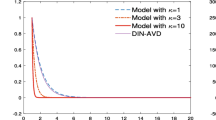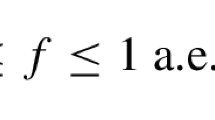Abstract
Consider minimizing the integral
where
ForT sufficiently small, it is shown that
where the functionx, viewed as a function ofT, is a solution of the Cauchy problem
and the auxiliary functionr satisfies the Riccati system
In the derivation of the Cauchy problem, no use is made of Euler equations, dynamic programming, or Pontryagin's maximum principle. Only ordinary differential equations are employed. The Cauchy problem provides a one-sweep integration procedure; it is intimately connected with the theory of the second variation.
Similar content being viewed by others
References
Courant, R., andHilbert, D.,Methods of Mathematical Physics, Vol. 1, John Wiley and Sons (Interscience Publishers), New York, 1966.
Bellman, R.,Introduction to the Mathematical Theory of Control Processes, Academic Press, New York, 1967.
Middleton, D.,Topics in Communication Theory, McGraw-Hill Book Company, New York, 1965.
Kagiwada, H., andKalaba, R.,Verification of the Invariant Imbedding Method for Certain Fredholm Integral Equations, Journal of Mathematical Analysis and Applications, Vol. 23, No. 3, 1968.
Kagiwada, H., andKalaba, R.,Derivation and Validation of an Initial Value Method for Certain Nonlinear Two-Point Boundary-Value Problems, Journal of Optimization Theory and Applications, Vol. 2, No. 2, 1968.
Kalaba, R., andSridhar, R.,Invariant Imbedding and the Simplest Problem in the Calculus of Variations, The RAND Corporation, Report No. RM-5781-PR, 1968.
Kagiwada, H., Kalaba, R., Schumitzky, A., andSridhar, R.,Cauchy and Fredholm Methods for Euler Equations, Journal of Optimization Theory and Applications, Vol. 2, No. 3, 1968.
Kalaba, R.,A New Approach to Optimal Control and Filtering, University of Southern California, Report No. USCEE-316, 1968.
Kalaba, R.,Dynamic Programming and Optimal Trajectories for Quadratic Variational Processes, The RAND Corporation, Report No. RM-5755-PR, 1968.
Kalaba, R.,Some Numerical Aspects of Unstable Boundary-Value Problems, Stability Problems of Solutions of Differential Equations, Edited by A. Ghizzetti, Edizioni Oderisi, Gubbio, Italy, 1966.
Bellman, R., Kagiwada, H., andKalaba, R.,Invariant Imbedding and the Numerical Integration of Boundary-Value Problems for Unstable Linear Systems of Ordinary Differential Equations, Communications of the Association for Computing Machinery, Vol. 10, No. 2, 1967.
Bolza, O.,Vorlesungen über Variationsrechnung, Koehler und Ameland, Leipzig, 1949.
Casti, J., Kalaba, R., andUeno, S.,Invariant Imbedding and the Variational Treatment of Fredholm Integral Equations with Displacement Kernels, The RAND Corporation, Report No. RM-5831-PR, 1968.
Bellman, R., andKalaba, R.,Quasilinearization and Nonlinear Boundary-Value Problems, American Elsevier Publishing Company, New York, 1965.
Author information
Authors and Affiliations
Rights and permissions
About this article
Cite this article
Kagiwada, H., Kalaba, R. Optimal trajectories for quadratic variational processes via invariant imbedding. J Optim Theory Appl 4, 99–108 (1969). https://doi.org/10.1007/BF00927415
Received:
Issue Date:
DOI: https://doi.org/10.1007/BF00927415




